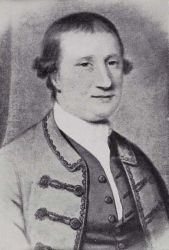Nationality Scottish Occupation landowner | Known for The "Forty Five" Name Sir Wedderburn, | |
 | ||
Died November 28, 1746, Scotland, United Kingdom | ||
Sir John Wedderburn, 5th Baronet of Blackness was a Perthshire gentleman who joined the 1745 rebellion of Charles Edward Stuart and, captured at the Battle of Culloden, was afterwards convicted of treason. He was hanged, his estates were forfeit to the Crown, and his family was attainted.
Contents
Early life
Wedderburn's expectations of an inheritance were not fulfilled and he fell on hard times. He raised his nine children in "a small farm with a thatched house and a clay floor, which he occupied with great industry, and thereby made a laborious but starving shift to support nine children who used to run about in the fields barefoot".
The "Forty Five"
In 1745 Sir John joined the rebellion of Charles Edward Stuart against the Hanoverian crown, serving as a colonel in the Jacobite army before being captured at the Battle of Culloden and hauled off to London to face trial and execution. He was indicted for treason at St Margaret's Hill, Southwark on 4 November 1746, and was found guilty, despite arguing in his defence that he had not personally taken up arms against the Crown, and was executed at Kennington Common on 28 November 1746.
Marriage and descendants
According to the genealogist Joseph Foster, Sir John married in 1724 Jean Fullerton, who lived till 1766. Foster only records details of two sons, John and James.
The eldest, known as John Wedderburn of Ballendean , made his way to London to plead with such friends as his family still had for his father's rescue and pardon. The boy's mission failed, and he had to witness his father's execution as a traitor by hanging, drawing and quartering. He returned to Scotland, and, with limited prospects there, decided to try for a new life in the New World. In Glasgow he found a ship's captain prepared to let him work his passage on a ship bound for the Caribbean. He spent many years as a planter in Jamaica, returning to Britain a wealthy man, enriched by slave sugar. He brought back with him a slave named Joseph Knight, who took him to court in a freedom suit which set a precedent in Scots law. Eventually John Wedderburn climbed back up the social scale, and his daughter Louisa married General John Hope, 4th Earl of Hopetoun.
The other son, James, also went to Jamaica, and there apparently fathered Robert Wedderburn by one of his slaves. Following Robert's rejection by his father's family, he wrote The Horrors of Slavery, which was circulated by the abolitionist movement.{{Malcolm Chase, ‘Wedderburn, Robert (1762–1835/6?)’, Oxford Dictionary of National Biography, Oxford University Press, 2004; online edn, May 2008 accessed 17 Oct 2016}} One of the descendants of Robert was Bill Wedderburn, Baron Wedderburn of Charlton (1927-2012). Others of James's children include Andrew Colvile, governor of the Hudson's Bay Company; Jean, who married Thomas Douglas, 5th Earl of Selkirk; and James Wedderburn, Solicitor General for Scotland until his death in 1822. The other surviving son was Peter Wedderburn Ogilvy, who became a sea captain
